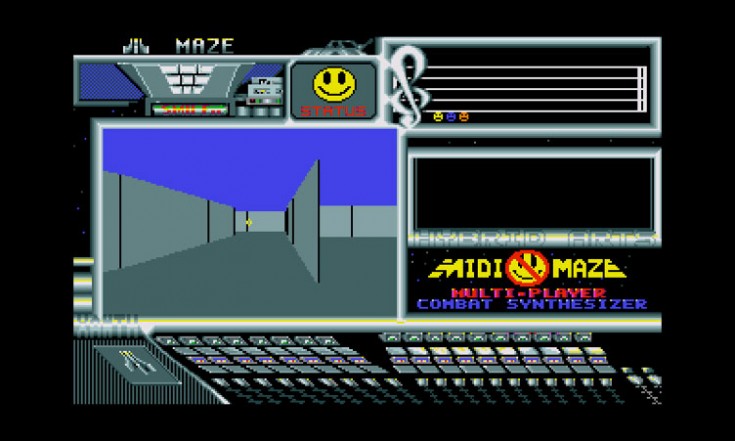
A world without multi-player gaming seems inconceivable today. Like macaroni without the cheese. Like Batman without Robin. Kim without Kanye. In fact it’s more likely we’ll be playing a multi-player game than not, whether that be at home with friends, in an online poker room, or playing FIFA with a man on the other side of the planet.
The growth of technology has made gaming more social than ever before, with the likes of Call of Duty, World of Warcraft, and Medal of Honour huge with internet players across the planet. But the art of multiplayer has a much more humble beginning.
The Eisenhower Years

Tennis for Two
Incredibly you can trace the history of the multiplayer game all the way back to 1958 and with a little game called ‘Tennis for Two’.
Developed by US physicist William Higinbotham the game ‘Tennis for Two’ evolved from simple boredom. The game was introduced as a way in which to entertain visitors to the Brookhaven National Laboratory in Upton, New York, and give them something fun to participate in. On its launch it managed to attract hundreds of visitors who had lined up in order to get a chance to play.
The game featured a simple simulated tennis game and utilised an oscilloscope as the graphical display for the gameplay. It was able to simulate velocity and drag and even incorporated sound to trigger when the virtual tennis ball was hit.
The Japanese Invasion

Pong
And from there, the big boys started to take over. Fast forward 14 years and it was now the turn of then newbie electronics company Atari to unveil something similar. Atari bought out their own version of the classic simulated tennis experience was to be released and branded as “Pong”. It was another extremely simplistic two-dimensional simulation of the game which allowed two players to compete for points by controlling two in-game paddles and hitting the ball back and forth. The game itself was based on a game featured on the Magnavox Odyssey, which was at the time the world’s first commercial home video game console and one which was unveiled mere months before Atari’s version of “Pong” came to fruition.
Atari redeveloped their “Pong” game for home use and 4 years later had released its home “Pong” console. Although originally developed to simply play this one popular game consequent versions were released featuring multiple new games, including Catch, Solitaire and Super Pong, which were all based on the same principals of the original tennis themed game. They were simply subtle variations and even though the market was huge and the money continued to pour in it seemed like the new and emerging gaming industry needed a fresh approach.
Plato’s New Philosophy

PLATO
In 1974 and years before the Internet as we now know it was even conceived there was PLATO (Programmed Logic for Automatic Teaching Operations). This exciting system combined thousands of computer terminals located around the world which would run from different networked machines on a mainframe. This was effectively an early Internet system that allowed multiple users to connect and share information. Users would be able to take part in online testing, converse in chatrooms, instant message and even play multiplayer games. The PLATO system was used as an engine on which a number of games could be played with a multiple players, one of which included Spasim. Spasim was a special 32-player 3D networked computer game run over the PLATO system. Players would compete and shoot against each on screens in a space-themed online arena each appearing as wire-framed spacecraft.
Acceptable In The 80s

Once more attempting to move things in the multiplayer universe on some more back in 1987 was Atari with the release of their new Atari ST which featured the ability to network multiplay through a MIDI interface. The game MIDI Maze was introduced that would let players take control of a smiley face to guide round a Pac-Man-esque labyrinth. The MIDI interface was utilised so that up to 16 players could connect to each other and create a so-called ‘MIDI ring’.
A Gaming Nirvana In The 90s

Playstation
By the early to mid-90’s network gaming has become been available on various consoles that now supported network gaming over LANs and the Internet and ever since then the technology has expanded and grown at an exponential rate. No longer was there a need to pack up your console and lug it over to your friend’s house just so you could connect up and begin playing. Now you could simply plug in a cable and join in the fun with literally millions of other live online gaming players from all around the world.
But then came the 2000s. And that changed everything. The Millennium, apart from everyone believing the world would end, saw gaming change forever, and in particularly poker.
Whilst the world was going crazy and electing Arnold Schwarzenegger Governor of California, online a man named Chris Moneymaker was revolutionising the world of online poker. Becoming the first person to be a World Series of Poker champion by qualifying online, he spawned the Moneymaker Effect, which saw a huge surge in players online, believing anyone can do it.

Online Gaming
From there online casinos have become huge, with multi-player casinos becoming more and more popular and sociable. The PokerStars multi-player casino has also bought these innovations to fruition to benefit the millions of online poker players out there, taking the social aspects we love in gaming and bringing it to the millions of members which play the likes of blackjack, roulette, and poker every day.
Its aim, like CoD, or WoW, or even FIFA, is to have players engage more with each other, giving a timer to each player to ensure play moves at a fair and enjoyable speed, whilst creating better players at the same time with the ability to share strategies and essentially make it a more realistic experience. You’d talk to players at a card room in Vegas, why shouldn’t you at PokerStars?
Now Then. Where To Go From Here?

Today, gaming has taken that even further. The likes of the PS4 and Xbox one have made it more accessible than ever before to play and socialise with people you’ve never met. In fact the PlayStation Network has over 110 million members, proving just how popular the world of multi-player gaming has become.
The past has led the path for some incredibly immersive gaming experiences that you can share with friends. Evolve, one of this year’s most highly anticipated games, has taken it to the next level, with four player-controlled hunters having to track down one player-controlled monster, in what is the first of its kind.
Which certainly bodes well for tomorrow. But what can we expect? Well that’s the exciting part. In the last few years technology has improved thick and fast. In just 2003 would we have expected to be in an online casino actually watching a croupier deal live and be able to communicate with them? In 1994 would we be believe that playing FIFA with your friends without them being in the room would be possible? Unless you’re Nostradamus, the answer is undoubtedly going to be no.
So it’s a little pointless making predictions, but what we do know is that it’ll make gaming more exciting, more fun, and of course an even better place to play.
